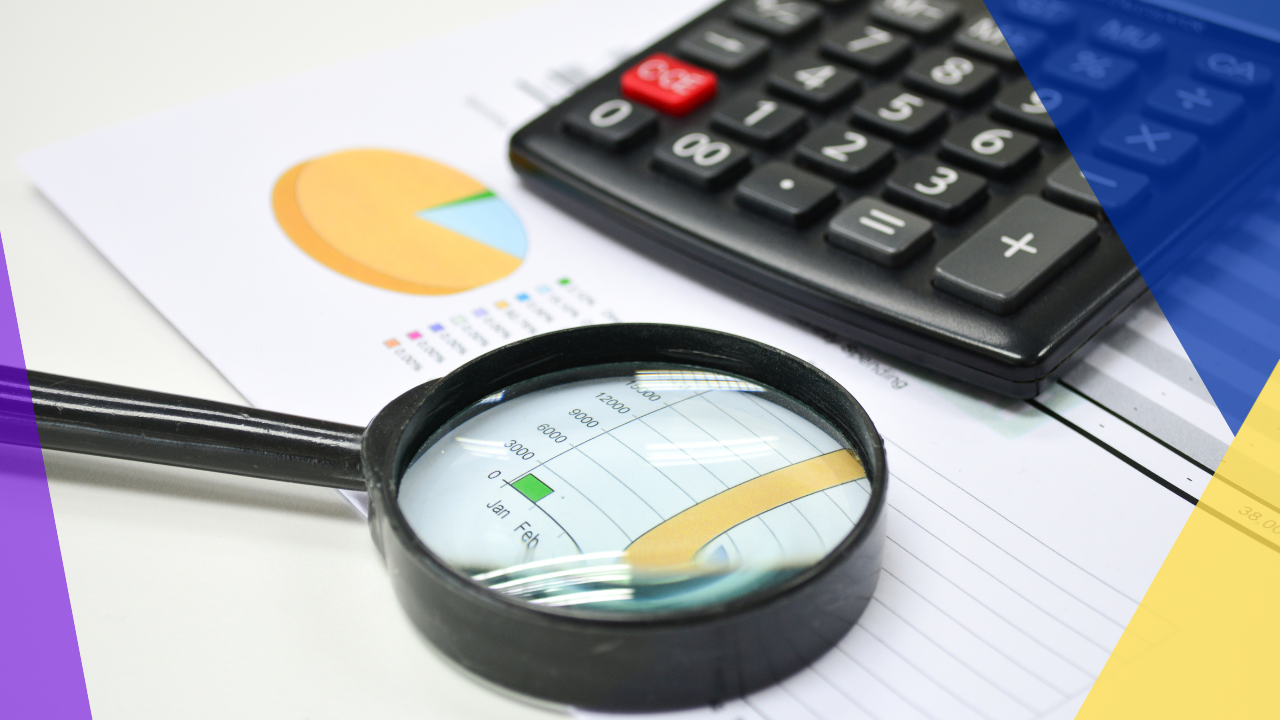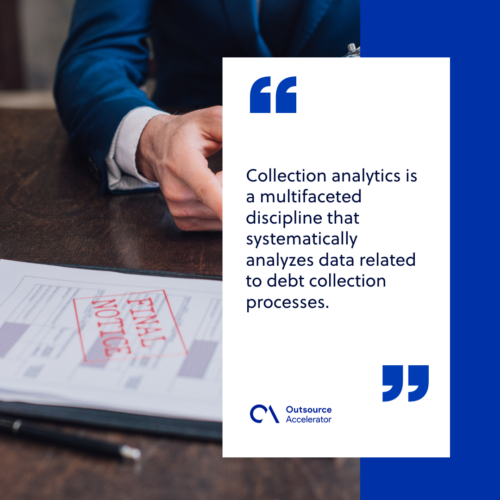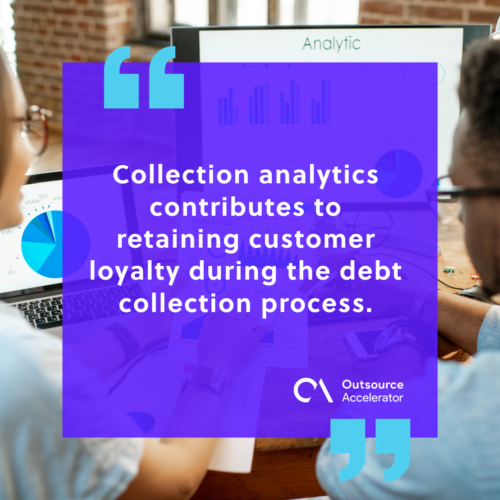What is collection analytics?

Debt collection firms have increasingly adopted analytics techniques to optimize their accounts receivable recovery.
Debt collection processing is an intricate and demanding facet of financial operations. It requires a meticulous approach due to its critical role in an organization’s fiscal health.
Each aspect, from data entry to debtor communication, necessitates accuracy and thoroughness. Any oversight or error can have significant repercussions, potentially impacting financial outcomes and relationships with debtors.
Through collection analytics, these debt collection agencies gain insights into customer preferences and behavioral patterns.
Collection analytics defined
Collection analytics is a multifaceted discipline that systematically analyzes data related to debt collection processes. It involves using sophisticated analytical techniques, statistical models, and data mining to extract valuable insights and patterns from vast information.
This data could include debtor profiles, payment histories, communication preferences, economic indicators, and other relevant metrics.
The primary goal of collection analytics is to optimize and improve debt recovery strategies by leveraging data-driven insights.

How does collection analytics work?
Collection analytics employs advanced data analysis techniques to derive actionable insights from broad historical data. These historical data are related to debtors, their repayment behaviors, and various contextual factors.
This process begins with accumulating and cleansing the following data sets:
- Debtor profiles
- Payment histories
- Communication records
- Economic indicators
- Other relevant information
Once gathered, this data undergoes rigorous analysis through statistical models, machine learning algorithms, and data mining methodologies.
The analysis aims to uncover data patterns, trends, and correlations. It allows organizations to segment debtors based on similarities in behaviors, demographics, or payment habits.
Through segmentation, distinct debtor groups are identified, enabling tailored strategies that align with the preferences and financial capacities.
Furthermore, collection analytics facilitates early intervention by identifying warning signs or potential delinquencies at an early stage.
This proactive approach enables organizations to intervene promptly, offering modified repayment plans or support to prevent further delinquency.
Strategies that benefit from collection analysis
In maximizing debt recovery efforts, various strategic approaches harness the power of collection analytics.
Understanding these strategies’ nuances and impact is crucial for effective debt management and successful outcomes.
Segmentation
Segmentation within collection analytics involves meticulously categorizing debtors into groups based on shared characteristics or behaviors.
This strategy allows collection agencies to tailor their approaches for each group. This means recognizing that different demographics or behavioral patterns may respond differently to collection efforts.
For instance, segmented groups might warrant varied communication channels or modified payment terms that align better with their preferences and financial capabilities.
This personalized approach fosters a more responsive and cooperative interaction between debtors and collection agencies.
Predictive modeling
Predictive modeling utilizes historical data and sophisticated statistical algorithms to anticipate future debtor behavior.
Organizations can create predictive models that forecast the likelihood of repayment or default through past repayment patterns, debtor attributes, and other relevant data points.
These models empower organizations to focus on high-potential accounts or anticipate potential challenges with specific debtors.
Early intervention
Early intervention strategies in collection analytics involve identifying and addressing potential misconduct at the early stages of debt. Collectors can detect early warning signs by scrutinizing debtor behaviors and financial circumstances.
This timely identification allows for swift intervention, wherein organizations can offer tailored assistance or modified repayment plans.
Compliance management
Collection analytics is also critical in ensuring adherence to legal and regulatory standards governing fair debt collection practices.
Organizations can systematically monitor and verify their practices by leveraging data analytics to ensure compliance with the relevant laws.
This proactive approach mitigates the risk of legal issues or penalties, safeguarding the reputation and operations of collection agencies.
Benefits of collection analytics
Collection analytics brings significant advantages that showcase the profound impact of data-driven collection methodologies on financial outcomes and customer relations.
Personalized negotiation
Collection analytics empowers organizations to examine and understand each individual debtor’s behaviors and preferences.
This way, collection agencies can create tailored negotiation strategies for different types of debtors.
Consequently, debtors are more likely to respond positively to negotiation efforts that resonate with their circumstances, significantly enhancing the prospects of successful repayment.
Managed reputation
Beyond debt recovery, effective collection analytics also plays a critical role in safeguarding an organization’s reputation.
Companies can build trust with debtors by employing fair and data-driven collection practices.
This transparent and ethical approach mitigates negative perceptions of aggressive or unfair collection methods.
Retained loyalty
Collection analytics contributes to retaining customer loyalty during the debt collection process. This is done by enabling organizations to adopt more empathetic and personalized approaches.
Instead of employing generic and impersonal collection methods, analytics-driven insights allow companies to understand the individual circumstances and preferences of debtors.
This understanding facilitates the creation of tailored solutions and repayment plans considering the debtor’s financial situation, communication preferences, and ability to repay.

Streamline the debt process with collection analytics
Collection analytics streamlines the debt recovery process by optimizing resource allocation.
Organizations can also prioritize accounts and tailor communication methods by leveraging data insights derived from this method.
Adopting this approach to your organization will lead to higher recovery rates while minimizing costs and efforts.







 Independent
Independent




